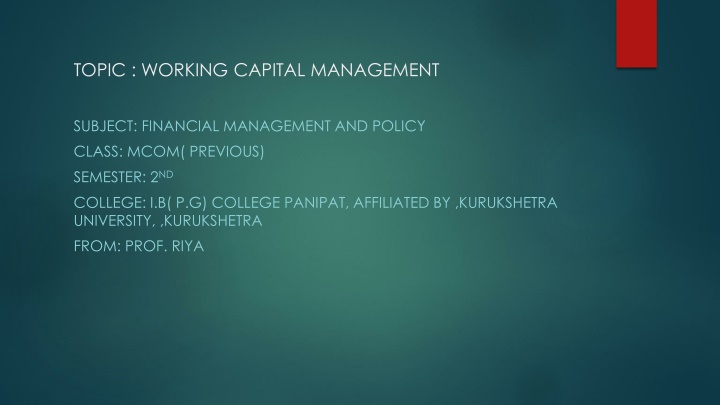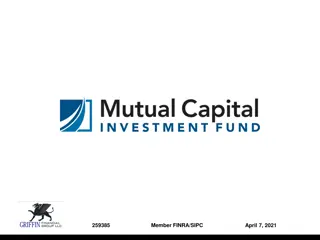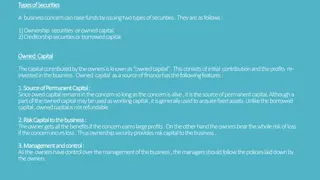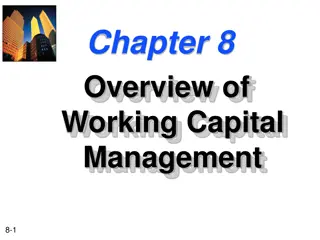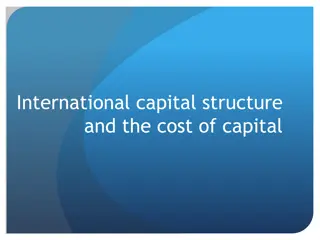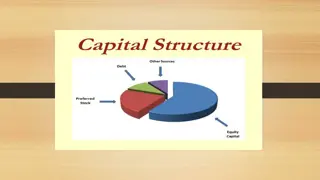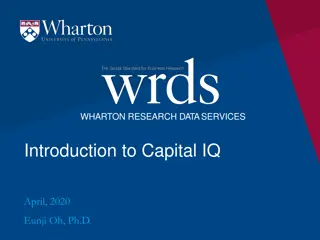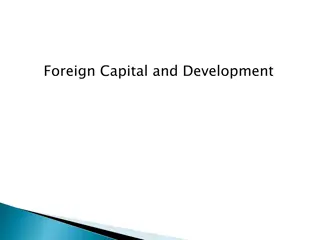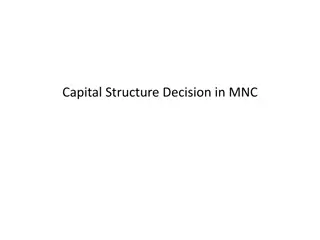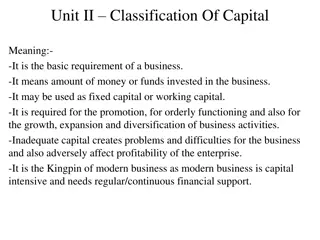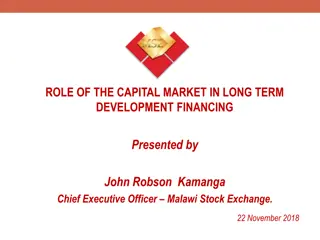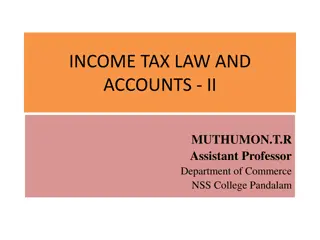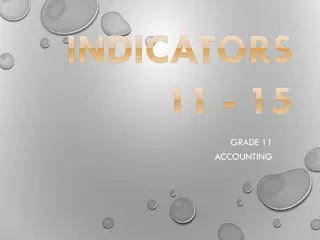TOPIC : WORKING CAPITAL MANAGEMENT
This subject delves into working capital management strategies focusing on efficient use of current assets and liabilities to maximize business operations and profitability. Through exploring various approaches, students gain insights into managing liquidity and optimizing resources to enhance organizational performance and sustainability.
Download Presentation

Please find below an Image/Link to download the presentation.
The content on the website is provided AS IS for your information and personal use only. It may not be sold, licensed, or shared on other websites without obtaining consent from the author.If you encounter any issues during the download, it is possible that the publisher has removed the file from their server.
You are allowed to download the files provided on this website for personal or commercial use, subject to the condition that they are used lawfully. All files are the property of their respective owners.
The content on the website is provided AS IS for your information and personal use only. It may not be sold, licensed, or shared on other websites without obtaining consent from the author.
E N D
Presentation Transcript
TOPIC : WORKING CAPITAL MANAGEMENT SUBJECT: FINANCIAL MANAGEMENT AND POLICY CLASS: MCOM( PREVIOUS) SEMESTER: 2ND COLLEGE: I.B( P.G) COLLEGE PANIPAT, AFFILIATED BY ,KURUKSHETRA UNIVERSITY, ,KURUKSHETRA FROM: PROF. RIYA
INTRODUCTION In an ordinary sense, working capital denotes the amount of funds needed for meeting day-to-day operations of a concern.This is related to short-term assets and short-term sources of financing. Hence it deals with both, assets and liabilities in the sense of managing working capital it is the excess of current assets over current liabilities. In this article we will discuss about the various aspects of working capital.
MEANING The funds invested in current assets are termed as working capital. It is the fund that is needed to run the day-to-day operations. It circulates in the business like the blood circulates in a living body. Generally, working capital refers to the current assets of a company that are changed from one form to another in the ordinary course of business, i.e. from cash to inventory, inventory to work in progress (WIP), WIP to finished goods, finished goods to receivables and from receivables to cash.
DEFINITIONS: Working capital, also known as net working capital (NWC), is the difference between a company s current assets, such as cash, accounts receivable (customers unpaid bills) and inventories of raw materials and finished goods, and its current liabilities, such as accounts payable. Net operating working capital is a measure of a company's liquidity and refers to the difference between operating current assets and operating current liabilities.
Main concept of Working Capital There are two concepts in respect of working capital: (i) Gross working capital and (ii) Net working capital.
Gross Working Capital: The sum total of all current assets of a business concern is termed as gross working capital. So, Gross working capital = Stock + Debtors + Receivables + Cash.
NET WORKING CAPITAL The difference between current assets and current liabilities of a business concern is termed as the Net working capital. Hence, Net Working Capital = Stock + Debtors + Receivables + Cash Creditors Payables.
NATURE OF WORKING CAPITAL The nature of working capital is as discussed below: i. It is used for purchase of raw materials, payment of wages and expenses. ii. It changes form constantly to keep the wheels of business moving. iii. Working capital enhances liquidity, solvency, creditworthiness and reputation of the enterprise. iv. It generates the elements of cost namely: Materials, wages and expenses. v. It enables the enterprise to avail the cash discount facilities offered by its suppliers.
NEEDS OF WORKING CAPITAL Working capital plays a vital role in business. This capital remains blocked in raw materials, work in progress, finished products and with customers. The needs for working capital are as given below: i. Adequate working capital is needed to maintain a regular supply of raw materials, which in turn facilitates smoother running of production process. ii. Working capital ensures the regular and timely payment of wages and salaries, thereby improving the morale and efficiency of employees. iii. Working capital is needed for the efficient use of fixed assets. iv. In order to enhance goodwill a healthy level of working capital is needed. It is necessary to build a good reputation and to make payments to creditors in time. v. Working capital helps avoid the possibility of under-capitalization
COMPONENTS OF WORKING CAPITAL: Working capital is composed of various current assets and current liabilities, which are as follows: (A) Current Assets: These assets are generally realized within a short period of time, i.e. within one year. Current assets include: (a) Inventories or Stocks (i) Raw materials (ii) Work in progress (iii) Consumable Stores
COMPONENTS OF WORKING CAPITAL (B) Current Liabilities: Current liabilities are those which are generally paid in the ordinary course of business within a short period of time, i.e. one year. Current liabilities include: (a) Sundry Creditors (b) Bills Payable (c) Accrued Expenses (d) Bank Overdrafts (e) Bank Loans (short-term
CLASSIFICATION OF WORKING CAPITAL Working capital may be of different types as follows: (a) Gross Working Capital: Gross working capital refers to the amount of funds invested in various components of current assets. It consists of raw materials, work in progress, debtors, finished goods, etc. (b) Net Working Capital: The excess of current assets over current liabilities is known as Net working . capital. The principal objective here is to learn the composition and . . . . magnitude of current assets required to meet current liabilities.
(c) Positive Working Capital: This refers to the surplus of current assets over current liabilities. (d) Negative Working Capital: Negative working capital refers to the excess of current liabilities over current assets (e) Permanent Working Capital: The minimum amount of working capital which even required during the dullest season of the year is known as Permanent working capital. (f) Temporary or Variable Working Capital: It represents the additional current assets required at different times during the operating year to meet additional inventory, extra cash, etc.
